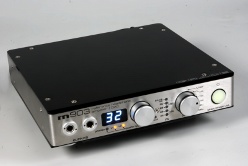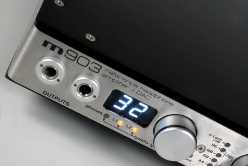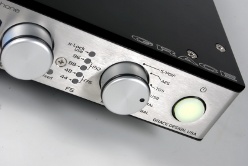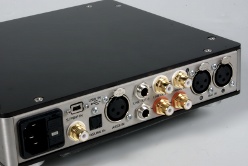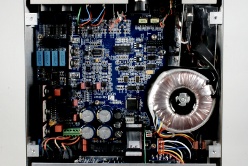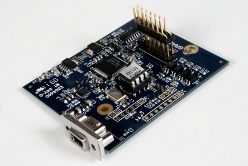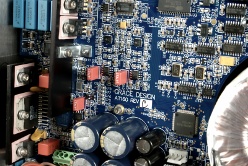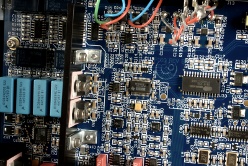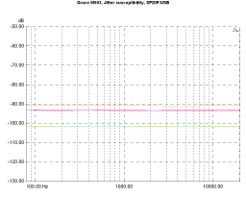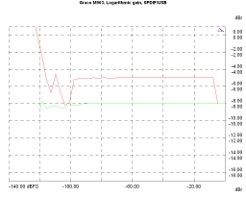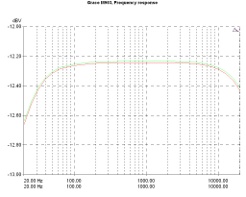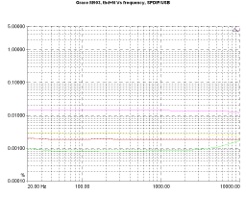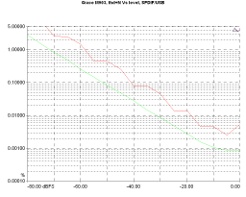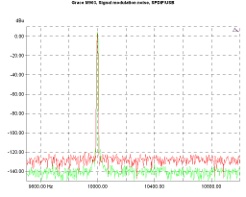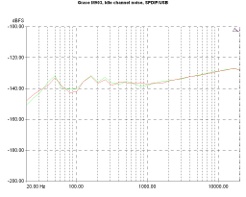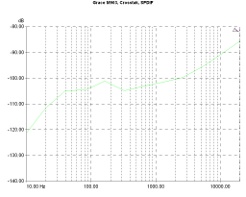Interesting Stories about Audio & Home Entertainment technologies
Last update: Jun. 13, 2012
USB DAC / HEADPHONE AMPLIFIER
Grace Design m903
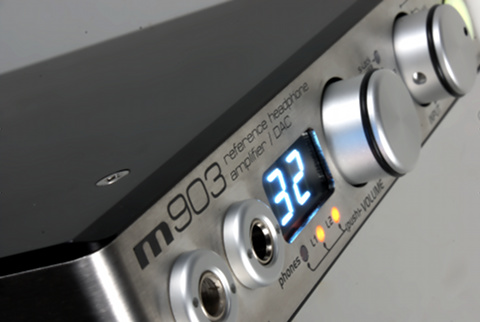
It is quite possible that you were not aware of the first edition of this particular device, the Grace 901. It was a headphone amplifier designed from a pro audio company for studio use and thus applying to a very specific audience: those who wanted a pretty good amplifier for monitoring. It's second edition, Grace m902, it is most possible that have captured your attention if only because of its timing of appearance, just when USB audio started to became interesting.
Almost aesthetically identical to the previous model, m903 includes some serious changes in its features. Apart from the usual digital inputs (optical and coaxial S/PDIF, AES3 και USB), there are two analog inputs, one single ended and one balanced. But, obviously, the most interesting feature is the improved USB port which can now handle signals up to 24/96 in Class 1, with no special drivers needed and goes up to 24/192 in Class 2 with special drivers.
m903 has maintained the large bright display which keeps the user informed about various settings in which he has access, browsing the menus. It has also maintained the two headphone outputs (1/4 inch jacks), the rotary input selector somewhat larger in diameter, as well as the LED indicators. There is, also, an option for a remote control.
Details
The standard PCM2902 chip has been abandoned in favor of a module based on an ΧΜΟS chip which is supported by the Thesycon's drivers for streaming up to 24/192, in asynchronous mode, a good effort towards jitter minimization.
Rest of the digital part is based on the Cirrus' CS8416 interface as well as on Burr Brown's PCM1798 dac chip. The company mentions that the i/v conversion is in balanced form, a task that seems to have been assigned to two chips from That (1570). The buffer output level is digitally controlled, through a CS3318 allowing to adjust separately level up to eight channels, offering possibility to control level and balance of each one of the three outputs separately. The level setting range is 99.5dB and the step is 0.5dB. Published technical specifications report 0.05dB balance between channels. Power supply is based on a toroidal transformer and a high count of local regulators. S-Clock, the jitter reduction system that has been developed by
Grace is, according to the company, quite improved, no further details given though. S-Clock uses two crystals and two PLLs, the first being used to lock to the source and extract the clock signal, while the second is used to drive the d/a chip.
Serious headphone users will be pleased to know, also, that m903 includes, as its predecessors, the xFeed circuit. Xfeed has been designed by Jan Meier (who is considered one of the gurus on headphones) and simulates the way human ear operates in free space (i.e. with no headphones) making the hearing more relaxed and realistic.
Lab Results
m903's measurements included high resolution signals (24bit/96kHz) both through coaxial (S/PDIF) and through USB port. S-Clock seems to be adequately effective offering low jitter susceptibility, as the distortion in the relevant graph appeared to be quite low (lower than -100dB). Less efficient, but anyway satisfactory, was the case with the USB port with the distortion moving to the -90dB region. In both cases, curves remain flat across the spectrum of jitter signal a rather positive behavior. Converter's linearity is also good, reaching -130dB in the S/PDIF input and exceeding this value through the USΒ port.
Frequency response cannot be seriously criticized since it appears to be flat for any practical purpose. There is a gradual cut-off near the bandwidth limits but it should be considered as negligible. Differences between channels vindicate manufacturer's claim about 0.05dB matching, at least at the 0dB attenuation where the measurement has been made. Harmonic distortion and noise of the device are quite low. Depending on the frequency, there is a small variation with the S/PDIF input being better, moving between 0.0008% and 0.003%, while the corresponding values through USB were 0.002% and 0.015% respectively.
m903's good behavior in low levels is also shown by the distortion vs level measurement. The curve goes down to -80dBFS (for 3% thd+N) for a measurement through the S/PDIF input and exceeded -70dBFS through USB, a performance that could be judged as pretty good. Signal modulation noise appears to be lower through S/PDIF input but there are intermodulation products very close to the fundamental tone. The same spectrum, measured through the USB port appears without this intermodulation skirt.
The converter is, in general terms, remarkably quiet. Static measurements are close to -120dB, with the noise from the power supply below -125dBFS, performance that justifies the design of Grace's power supply. The idling noise diagram confirms these findings, being in total below -120dBFS, with a small peak at 50Ηz. Finally, crosstalk was below -100dB for signals up to 2kHz and below -85dB for signals up to 20kHz.
Listening
Using standard resolution digital audio, first impression was that of a neutral, clear and somewhat laid back device, practically transparent, without a distinct sonic identity. Grace's new DAC creates a sense of closeness, bringing listener in proximity with the sound stage and offers very good resolution in both the horizontal and the depth axes. Music material based on small ensembles was described in great detail, while the symphonic orchestra was impressive both in imaging and dynamics. Lows were extended and maintained the ability to, also, impress with their good control and accuracy. Midrange was on a similar level: The converter seemed to fully respect mixing proportions, transfer the fine details which characterize the human voice and still remain easy to listen to, without becoming euphonic. Highs offered a feeling of transparency and liveliness with a slight tendency for over damping but without any harshness.
With high resolution material, as one would expect, results have been improved further. In this case, the low noise and the close channel matching could have played a greater part. The listener finds in front of him an excellent sound scene with lots of micro details and a remarkably vivid image. Additionally, the listener gets a feeling of wider dynamics and a sense of greater tonal balance, in a way that the converter becomes even more relaxing and easy to listen to, even in high levels.
Using a pair of Grado Reference RS2 I enjoyed extended low frequencies, a comfortable sense in highs and good enough resolution as far as position of sources in the stereo image is concerned (always a weak point in listening through headphones). The xFeed improves things in most cases functioning in a mild, unobtrusive way, thus remaining a significant tool at listener's disposition when he considers it necessary.
Conclusion
Most probably, Grace delayed a bit to present m903 losing ground in the USB DACs market, but, to my opinion, it was worth it. Instead of being limited to a simple upgrade (XMOS module would have been enough for this purpose) there are interesting changes in almost all respects. The final result is a device with very good sound and great functionality far more than one expects from just another USB/DAC box.
Equipment used during listening sessions
Teac Esoteric P70/D70, Nirvana DC-110, dCS Puccini U-Clock, Melos Plus Series Line, Copland DRC-205, Parasound HCA3500, ATC SCM-50PSL
LISTENING SESSIONS
The following recordings were made with a DV-RA1000 Tascam master recorder (using 24bit/192kHz sample rate) and you can download them to have an impression of what the device under review sounded like. It is obvious that any recording of this kind could not be absolutely transparent but, according to our experience, the majority of sound attributes we listen to, during the actual listening sessions, are preserved. The file format is .wav, so expect that the zipped files will be quite large (even if the clips are about a minute or less long. You could use a ABX listening plug-in like the ABX plug-in for foobar2000 if you want to make some more elaborate experiments. Contact is if you have any questions.
TRACK LIST:
Grace Design m903
| Specifications (Data according to the manufacturer | |
|---|---|
| Description: | USB/DAC, Headphone Amplifier |
| Compatibility: | 32kHz-192kHz, 16bit-24bit |
| Digital inputs: | 1x coaxial S/PDIF, 1x optical S/PDIF, 1x AES3 |
| USB port: | Asynchronous mode, Class 1/Class 2, 24bit/192kHz with additional drivers (Thesycon) |
| Analog inputs: | 1x single ended, 1x balanced |
| Analog outputs: | 2x headphones, 1x single ended (RCA) 1x balanced (? inch jack) |
| Other features: | Independent output level adjustment for each output, xFeed circuit, S-Clock timing circuit, optional remote control. |
| Dimensions: | 216x43x210 (mm, wxhxd) |
| Weight: | 2.2kg |
| Price & More Info | |
|---|---|
| Grace Design m903: | €1932.- (price list, for Greek market), €105.- for the remote control. |
| More Information: | web: http://www.gracedesign.com/ |
| Review Sample: | Αthens Pro Audio |

